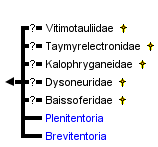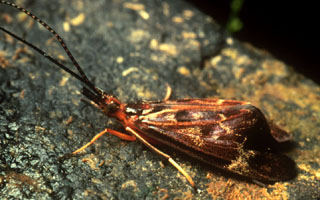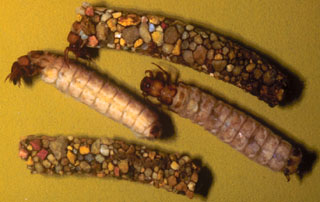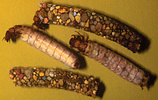Integripalpia
Tube case makers
Ralph W. Holzenthal, Roger J. Blahnik, Aysha Prather, and Karl Kjer


This tree diagram shows the relationships between several groups of organisms.
The root of the current tree connects the organisms featured in this tree to their containing group and the rest of the Tree of Life. The basal branching point in the tree represents the ancestor of the other groups in the tree. This ancestor diversified over time into several descendent subgroups, which are represented as internal nodes and terminal taxa to the right.

You can click on the root to travel down the Tree of Life all the way to the root of all Life, and you can click on the names of descendent subgroups to travel up the Tree of Life all the way to individual species.
For more information on ToL tree formatting, please see Interpreting the Tree or Classification. To learn more about phylogenetic trees, please visit our Phylogenetic Biology pages.
close boxIntroduction
Integripalpia are the most speciose trichopteran suborder with xxx species, according to the Trichoptera World Checklist (Morse, 2010). Integripalpia are common, and cosmopolitan. Larvae construct tubular cases, made from a wide variety of materials, and in a wide variety of architechture. The larva extends its head and legs out the anterior end of the case as it feeds and crawls on the substrate. To increase the size of the case, they simply extend or add to the anterior end with each larval instar, eventually pupating inside the slightly modified larval case. Case-making larvae are primarily detritivores. They feed by shredding and ingesting dead leaves and other plant parts largely of riparian origin. Predation is also common among the case-makers, but herbivory on living plants is less common. Other casemakers feed by scraping the diatoms, other algae, and fine detritus that makes up the periphyton or biofilm. A very few are filterers or snag drifting prey.
Weaver (1984) restricted the concept of Integripalpia to include only the Limnephiloidea of Ross, and this is the sense in which it is used here.
Characteristics
Synapomorphies of the Integripalpia (from Weaver, 1984)
- Larva with mesonotum completely sclerotized (secondarily reduced in Phryganeidae)
- Female abdominal segment X with pair of dorsolateral appendages
- Female genitalia blunt with abdominal segments X and XI reduced and cerci absent
- Female genitalia without cloaca; vulva, and rectum with separate openings, vulva opening ventrally between abdominal sterna VIII and IX or within sternum IX and rectum opening posteriorly from abdominal sternum IX
- Female without long internal apophyses on abdominal segment VIII and IX
- Larval abdomen segment I with lateral and mid-dorsal humps
- Larva with lateral series of spicules on abdominal segments II-VIII
Discussion of Phylogenetic Relationships
The monophyly of Integripalpia has never been seriously questioned. Ross (1956) identified Integripalpia based on a progression of case making behaviors. Weaver (1984), in the first cladistic analysis based on morphology, recovered Integripalpia as monophyletic, as did subsequent morphological analyses (Frania and Wiggins, 1997; Ivanov, 2002). All combined molecular analyses have recovered Integripalpia (Kjer et al., 2001; 2002; Holzenthal et al. 2007), as have partitioned analyses from mitochondrial data (Kjer et al., 2001).References
Holzenthal R.W., Blahnik, R.J., Kjer K.M and Prather, A.L. 2007. An update on the phylogeny of Caddisflies (Trichoptera). Proceedings of the XIIth International Symposium on Trichoptera. Bueno-Soria, R. Barba-Alvearz and B. Armitage (Eds). pp. 143-153. The Caddis Press.
Frania, H. E., & G. B. Wiggins. 1997. Analysis of morphological and behavioural evidence for the phylogeny and higher classification of Trichoptera (Insecta). Pages 67 in Life Sciences Contributions Royal Ontario Museum, Toronto.
Ivanov, V. D. 2002. Contribution to the Trichoptera phylogeny: new family tree with considerations of Trichoptera-Lepidoptera relations. Nova Supplementa Entomologica (Proceedings of the 10th International Symposium on Trichoptera) 15: 277-292.
Kjer, K. M., R. J. Blahnik, & R. W. Holzenthal. 2001. Phylogeny of Trichoptera (caddisflies): characterization of signal and noise within multiple datasets. Systematic Biology 50: 781-816.
Kjer, K. M., R. J. Blahnik, and R. W. Holzenthal. 2002. Phylogeny of Caddisflies (Insecta, Trichoptera). Zoologica Scripta 31(1): 83-91.
Morse, J.C. (ed.) 2010. Trichoptera World Checklist. http://entweb.clemson.edu/database/trichopt/index.htm
Ross, H.H. (1956) Evolution and Classification of the Mountain Caddisflies. University of Illinois Press, Urbana, 213 pp.
Weaver, J.S., III. 1984. The evolution and classification of Trichoptera, Part 1: the groundplan of Trichoptera. Pages 413-419 in J.C. Morse (editor). Proceedings of the 4th International Symposium on Trichoptera. Dr. W. Junk Publishers, The Hague.
Weaver, J.S. III & J.C. Morse. 1986. Evolution of feeding and case-making behavior in Trichoptera. Journal of the North American Benthological Society 5(2): 150-158.
Title Illustrations

| Scientific Name | Phylloicus ornatus |
|---|---|
| Location | Guanacaste, Costa Rica |
| Specimen Condition | Live Specimen |
| Copyright | © 1997 David Funk |
About This Page
Ralph W. Holzenthal

University of Minnesota, St. Paul, Minnesota, USA
Roger J. Blahnik

University of Minnesota, St. Paul, Minnesota, USA
Aysha Prather

Centre for Biodiversity and Conservation Biology, Royal Ontario Museum, Toronto, Ontario, Canada
Karl Kjer

Rutgers University, New Brunswick, New Jersey, USA
Correspondence regarding this page should be directed to Ralph W. Holzenthal at , Aysha Prather at , and Karl Kjer at
Page copyright © 2010 Ralph W. Holzenthal, Roger J. Blahnik, Aysha Prather, and Karl Kjer
 Page: Tree of Life
Integripalpia. Tube case makers.
Authored by
Ralph W. Holzenthal, Roger J. Blahnik, Aysha Prather, and Karl Kjer.
The TEXT of this page is licensed under the
Creative Commons Attribution-NonCommercial-ShareAlike License - Version 3.0. Note that images and other media
featured on this page are each governed by their own license, and they may or may not be available
for reuse. Click on an image or a media link to access the media data window, which provides the
relevant licensing information. For the general terms and conditions of ToL material reuse and
redistribution, please see the Tree of Life Copyright
Policies.
Page: Tree of Life
Integripalpia. Tube case makers.
Authored by
Ralph W. Holzenthal, Roger J. Blahnik, Aysha Prather, and Karl Kjer.
The TEXT of this page is licensed under the
Creative Commons Attribution-NonCommercial-ShareAlike License - Version 3.0. Note that images and other media
featured on this page are each governed by their own license, and they may or may not be available
for reuse. Click on an image or a media link to access the media data window, which provides the
relevant licensing information. For the general terms and conditions of ToL material reuse and
redistribution, please see the Tree of Life Copyright
Policies.
- Content changed 20 July 2010
Citing this page:
Holzenthal, Ralph W., Roger J. Blahnik, Aysha Prather, and Karl Kjer. 2010. Integripalpia. Tube case makers. Version 20 July 2010 (under construction). http://tolweb.org/Integripalpia/14551/2010.07.20 in The Tree of Life Web Project, http://tolweb.org/









 Go to quick links
Go to quick search
Go to navigation for this section of the ToL site
Go to detailed links for the ToL site
Go to quick links
Go to quick search
Go to navigation for this section of the ToL site
Go to detailed links for the ToL site